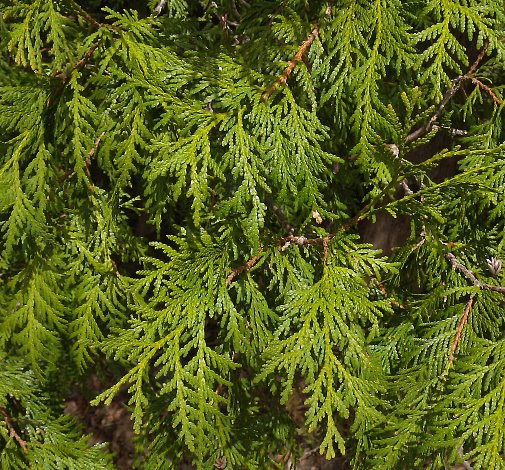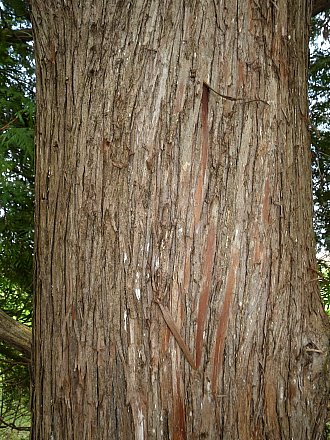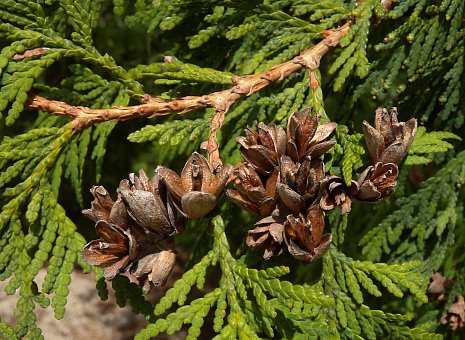
Northern White Cedar is monoecious, developing male pollen cones and female seed cones on the branchlets of the same tree. The blooming period occurs from late spring to early summer; the cones are cross-pollinated by the wind. The male cones are about 2 mm. long, rounded, and yellowish in color. The female cones are initially pink to purple, but they become brown and woody at maturity later in the same year. Mature female cones are 9-13 mm. (1/3 to 1/2") long, ellipsoid in shape, and more or less erect; they usually occur in loose clusters on the branchlets. Each female cone has several pairs of appressed overlapping scales that are ovate in shape and minutely mucronate (with rounded tips, except for tiny points at their centers); these scales spread apart to release their seeds from late summer into the fall. Each mature female cone has about 8 seeds (4 fertile scales with 2 seeds each). Individual seeds are about ¼" in length and brown with membranous wings. They are distributed by the wind. The root system is shallow and spreading. Northern White Cedar can reproduce by layering when its branchlets extend into moist soil; the woody branches can also develop roots when a tree falls to the ground.
Cultivation: The preference is full sun to light shade, moist conditions, and a peaty calcium-rich soil that has a neutral to alkaline pH. In the southern portion of its range (including Illinois), Northern White Cedar prefers some protection from the sun during the afternoon. This tree develops slowly, but it can live 400-800 years under favorable conditions. However, individual trees are often damaged or killed by fire, strong winds, ice storms, heavy snow, and other problems.
Range & Habitat: Northern White Cedar is restricted to NE Illinois, where it is native. In natural areas, this tree is rare and state-listed as 'threatened.' However, it is more common in boreal areas to the north of the state. In Illinois, habitats consist of forested fens, seeps, and springs. Outside of the state, it also occurs in forested bogs and along rocky cliffs. This tree has been extirpated from some localities within Illinois because of development. It is also threatened by an overpopulation of deer within the state. Northern White Cedar is widely cultivated throughout the state as a landscape tree in yards, parks, and cemeteries. However, these cultivated trees have rarely, if ever, escaped into natural areas.
Faunal Associations: Northern White Cedar is a host plant of various insects. Both the Black Carpenter Ant (Camponotus pennsylvanicus) and Red Carpenter Ant (Camponotus ferrugineus) develop chambers within the rotting wood of the trunk and branches of older trees. Larvae of the moths Argyresthia aureoargentella, Argyresthia thuiella, and Coleotechnites thujaella mine the scale-like leaves. Other moth larvae that feed on this tree include Thyridopteryx ephemeraeformis (Evergreen Bagworm), Ematurga amitaria (Cranberry Spanworm), Digrammia continuata (Curve-Lined Angle), and Anomogyna badicollis (Northern Variable Dart); the larvae of this last moth attack young seedlings. Other insect feeders include the larvae of Monoctenus melliceps (Arborvitae Sawfly), Carulaspis juniperi (Juniper Scale), Parthenolecanium fletcheri (Fletcher Scale), Cinara tujafilina (Arborvitae Aphid), the plant bugs Dichrooscytus elegans and Dichrooscytus repletus, and the larvae of Phyllobius intrusus (Arborvitae Weevil). The larvae of Phloeosinus canadensis (Northern Cedar Bark Beetle) bore through the wood, as do the larvae of several long-horned beetles: Atimia confusa confusa, Callidium frigidum, Eupogonius tomentosus, and Semanotus ligneus ligneus (Cedar Tree Borer). In addition, the foliage of this tree is attacked by some species of spider mites: Calepiterimerus thujae (Tip-Dwarf Mite), Oligonychus ununguis (Spruce Spider Spite), and Platytetranychus thujae (Arborvitae Spider Mite).

Some vertebrate animals are associated with Northern White Cedar and its surrounding habitat. Such birds as the Ruffed Grouse, Pine Siskin, Common Redpoll, Slate-Colored Junco, and Tree Sparrow eat the seeds or cones, as does the Red Squirrel. The branchlets and twigs of this tree are the preferred winter browse of White-Tailed Deer, which also find shelter within stands of Northern White Cedar during the winter. The Pileated Woodpecker searches for carpenter ants within the wood of older trees. Because of its dense branching habit and evergreen foliage, this tree provides good nesting habitat for such migratory songbirds as the Cape May Warbler, Blackburnian Warbler, and Golden-Crowned Kinglet (north of Illinois); the Ovenbird constructs its nests on the ground within stands of Northern White Cedar (also north of Illinois). Other migratory songbirds that are attracted to this tree during the summer include the Swainson's Thrush, Northern Parula, Black-Throated Green Warbler, Black-and-White Warbler, Magnolia Warbler, and White-Throated Sparrow.

Photographic Location: Along a roadside in Urbana, Illinois.
Comments: If it is planted in an appropriate location, Northern White Cedar is a beautiful tree that has foliage with a pleasant fragrance. In spite of its common name, this tree is more closely related to a cypress or juniper, rather than a true cedar. Another common name for this tree is American Arborvitae. Many cultivars have been developed that vary in size, shape, color of foliage, and tolerance of heat. There are also Asiatic Thuja spp. that are often cultivated, although there are no records of their naturalizing in Illinois. Generally, these Asiatic species have less flattened branchlets than Northern White Cedar, and there are differences in the characteristics of their seed cones.